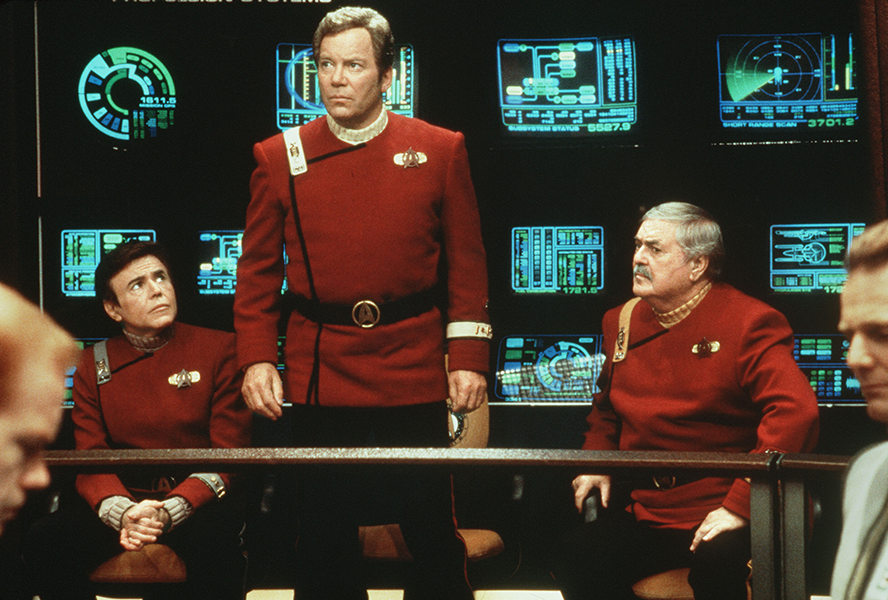How to celebrate the 50th anniversary of 'Star Trek' this year
Loading...
“Star Trek” fans have a lot to look forward to over the next several months.
The 50th anniversary of the original TV show, which starred William Shatner and Leonard Nimoy and premiered in September 1966, is approaching. Various celebrations will honor the legacy of the TV show, which spawned multiple spin-off TV programs and movies (including a new movie, “Star Trek Beyond,” due this summer and a new CBS TV show that will debut in 2017).
A convention titled Star Trek: Mission New York will take place from Sept. 2 to Sept. 4 in New York City.
According to USA Today, “Trek Talks” will take place beginning this July, with various leaders in their fields examining science and diversity, among other topics inspired by “Trek.” These will be at science museums, places of entertainment, and schools.
“’Star Trek’ – 50 Artists. 50 Years” will debut at this July’s Comic-Con in San Diego and have art based on “Trek,” including work done by Leonard Nimoy, who died in 2015.
A program titled Starfleet Academy Experience will let Trekkers be part of Starfleet Academy at Ottawa’s Canada Aviation and Space Museum and New York’s Intrepid Sea, Air & Space Museum. Those who participate will gain knowledge about piloting and engineering, among other topics, all with a “Trek” spin.
“Star Trek” has been heralded as a program that promoted good relations between people and the pursuit of knowledge. The show takes place in the future and centers on Starfleet, which is tasked with stopping war in the universe and helping others.
Original actor Leonard Nimoy, who died in 2015, spoke about the themes of the show in a past interview.
“It's all about trying to make the world and the universe a better place," he said in an interview with the Reno Gazette-Journal. "I'm proud to be connected with it. I think we need that in our lives. We need ethical, heroic people trying to do the right thing to help others and to improve life on this planet and in the universe.”
The original TV show has also been noted for a 1968 sequence in which characters Captain James T. Kirk (Shatner) and Uhura (Nichelle Nichols) kiss and which aired during a time when white and African-American actors kissing onscreen was still far from the norm.
Nichols recalled in an interview that Shatner was determined that the sequence air despite nervousness from the network, NBC. Series creator Gene Roddenberry told those on set to film with the kiss and without the kiss after two representatives from NBC came on set and spoke with the director.
When they filmed the takes without the kiss, Nichols remembered, “Bill kept acting ridiculous through them and in that final shot, he crossed his eyes. But it wasn’t until we saw the dailies that any of us knew what he’d done… the NBC suits were forced to let us air the kiss.”
The cast of the original show was a diverse one, also including an Asian character (Sulu, portrayed by George Takei) and a Russian one (Chekov, portrayed by Walter Koenig) at a time when relations were tense between the U.S. and U.S.S.R.
For some viewers, “Star Trek” inspired a love for space, math, and science. David McBride, who went on to become the director of NASA’s Dryden Flight Research Center, said, “I was influenced watching ‘Star Trek’ growing up and I think in a big way that led to my career in science and technology.”
Astronaut Mae Jemison, who in 1992 became the first African American woman to travel into space, also said she was inspired by the show.
“I saw 'Star Trek: The Original Series' as a little girl and for me, it was really great because it talked about and it dealt with situations that were going on at the time, but you saw it with a lens of another place, another time, another world, another group of people,” she said in an interview with Space.com.
The show is also often credited with inspiring innovation in the technology world. When Motorola director of research and development Martin Cooper designed the first mobile phone, he cited the communicator used by “Star Trek” characters as having helped him. “That was not fantasy to us, that was an objective,” Cooper said, according to Smithsonian Magazine.






